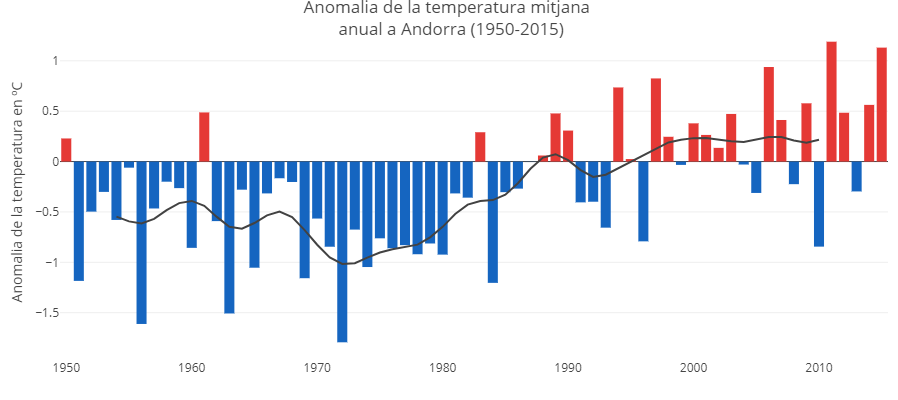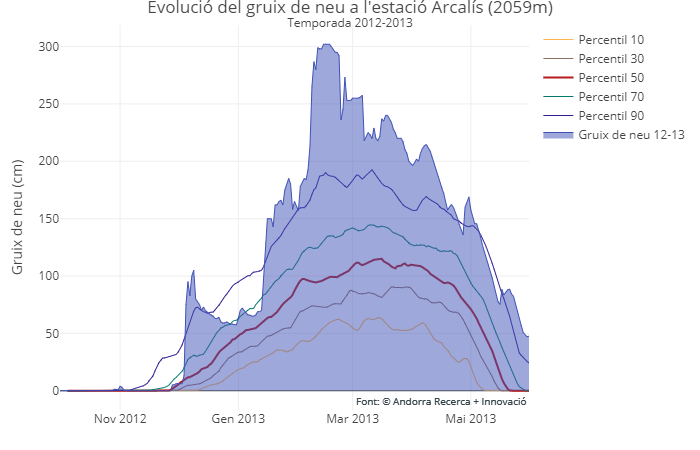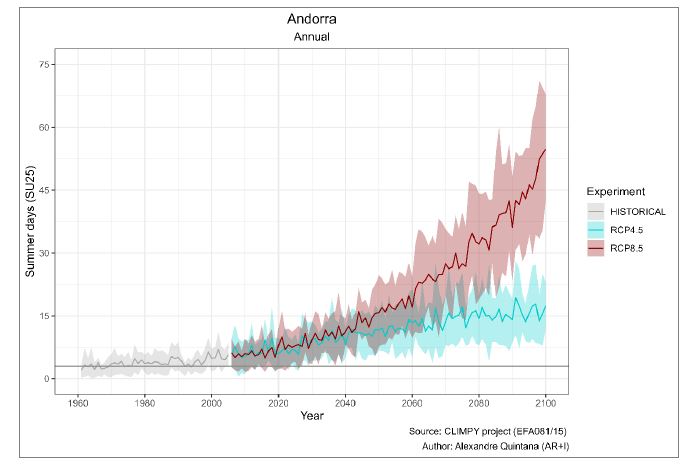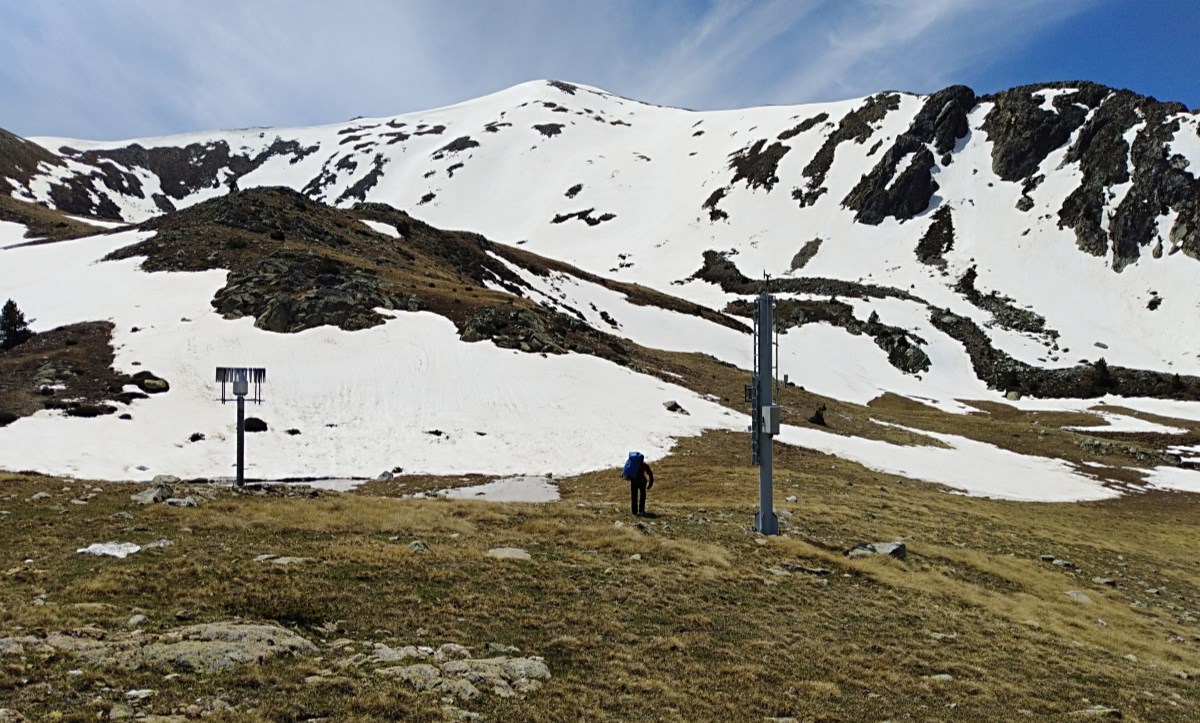Projects

The main objective defined in the CLIM’PY project is to know the evolution and trend of the climate of the Pyrenees in the context of global change. existing information has been unified and homogenized, climate indicators and future projections have been developed, with the intention of reducing the vulnerability of impacts caused by climate change and adapting to its effects through the transfer of knowledge [1 ].
The study was approached from a comprehensive territorial perspective. Climate is understood as a continuous variable in space that requires a common protocol of action on information, results and spatial representation [2]. In addition to the temperature and precipitation, the project also includes knowledge of snow, due to its outstanding interest in a mountainous area such as the Pyrenees. The results will contribute to the development of the strategy and action plan of the OPCC (Pyrenean Climate Change Observatory). In addition, it will provide knowledge to assess the impacts on the territory (water resources, ecosystems, biodiversity, tourism, energy, etc.), and propose options for adaptation to climate change [3].
The objectives of the project have allowed:
- Quality and homogeneous daily climate database of the three historic stations of Andorra.
- Calculate the trends and know the magnitude of global warming detected in Andorra.
- Have a continuous snow database of ski resorts in the Pyrenees massif and Andorra.
- Climatic projections of temperature, precipitation and depth of snow on the different horizons and scenarios of greenhouse gas emissions throughout the Andorran massif and different altitudes.
The main results are published on the OMA (Observatori de la Muntanya d'Andorra). The evolution of the temperature shows an unequivocal increase over the last fifty years, with an increase of 0.18ºC / decade with respect to the average annual temperature. The most obvious increase is in maximum temperatures, especially in summer (0.29ºC / decade). In contrast, precipitation shows marked temporal variability.

The analysis of the historical data of snow depth measured in the ski resorts have allowed to describe on a Pyrenean scale the evolution of the snow cover from 1983 to the present. The methodology followed in the project has allowed to reconstruct the gaps in the time series of snow depth from the simulations obtained from the SAFRAN (meteorological analysis) - CROCUS (model of evolution of the snow cover) for the period 1980- 2016. The fact of combining the observations in situ and the models, has allowed to improve the quality of the data and also to give continuity to the series during all the season. Both the early snowfalls and the melting season in late winter have been captured, when the ski resorts are not open and therefore no observations are made. [4]

(Interactive plot)
Continuing with the objectives of the project, in terms of climate projections of temperature and precipitation, Àlex Quintana Clarà, who has completed his degree in Geography, Territorial Analysis and Sustainability (URV), has been able to work on climate projections of temperature and precipitation this year. His TFG was entitled "Climate change projections in Andorra: analysis and calculation of indicators in the framework of the national strategy for adaptation to climate change".
In their work, high-resolution (5 km x 5 km) climate change projections obtained in the framework of the POCTEFA CLIMPY project [5] for the Andorran territory have been used to contextualise climate evolution under different possible future scenarios (RCP4.5 and RCP8.5). In addition to temperature and precipitation projections for different forecast horizons, different indices have been calculated that can be used within the national climate change adaptation strategy to characterise Andorra's climate. This procedure makes a reflection on how to use the information available in high resolution from two altitudinal bands. The results indicate that for temperature, the positive trends already detected at present will be maintained during this century, being more marked for the maximum temperature than for the minimum temperature. The climate projections also show how the increase in temperature will be proportional to the increase in GHG (Greenhouse Gas) emissions for each of the two scenarios analysed (RCP4.5 and RCP8.5). Unlike temperature, future precipitation projections do not show a clear trend.

The paper can be found at the following link.
This project is funded by the Interreg-POCTEFA program and by the Government of Andorra through the Complementary Grants to the POCTEFA 2014-2020 reference AUEP002-AND / 2015.
[1] P. Esteban, M. Prohom, E. Aguilar, "Tendencias recientes e índices de cambio climático de la temperatura y la precipitación en Andorra, Pirineos (1935-2008)." Revista de Ecología de Montaña, 2012.
[2] P. Esteban, M. Prohom, J. Cunillera, L. Trapero, "Tendències recents del clima a Andorra (1950-2010): Resultats de l’acció Clima del projecte OPCC." Revista del CENMA, 2018.
[3] R. Copons, B. Komac, C. Pladevall, M. Pons, L. Trapero, "El canvi climàtic i els impactes en la biodiversitat." Revista del CENMA, 2018.
[4] J.I. López Moreno, J.M. Soubeyroux, S. Gascoin, E. Alonso-gonzalez, N. Durán-gómez, et al., "Long-term trends (1958–2017) in snow cover duration and depth in the Pyrenees." International Journal of Climatology, 2020.
[5] M. P. Amblar-Francés, P. Ramos-Calzado, J. Sanchis-Lladó, A. Hernanz-Lázaro, M.C. Peral-García, B. Navascués, M. Dominguez-Alonso, M. A. Pastor-Saavedra, E. Rodríguez-Camino: High resolution climate change projections for the Pyrenees region, Adv. Sci. Res., 17, 191–208, https://doi.org/10.5194/asr-17-191-2020, 2020.

 Anna Albalat
Anna Albalat Laura Trapero
Laura Trapero
